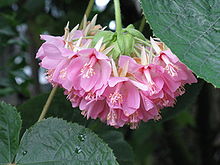Dombeya
| Dombeya | |
|---|---|
 |
|
| Pink-ball (Dombeya wallichii) inflorescence | |
| Scientific classification | |
| Kingdom: | Plantae |
| (unranked): | Angiosperms |
| (unranked): | Eudicots |
| (unranked): | Rosids |
| Order: | Malvales |
| Family: | Malvaceae |
| Subfamily: | Dombeyoideae |
| Genus: |
Dombeya Cav. |
| Species | |
|
Several, see text |
|
| Synonyms | |
|
Acropetalum A.Juss. |
|
Several, see text
Acropetalum A.Juss.
Assonia Cav.
Astrapaea Lindl.
Cavanilla J.F.Gmel. (non Vell.: preoccupied)
Hilsenbergia Boj.
Koenigia Comm. ex Juss. (non L.: preoccupied)
Leeuwenhoeckia E.Mey. ex Endl.
Stewartia Comm. ex Adans. (non L.: preoccupied)
Vahlia Dahl
Walcuffa J.F.Gmel.
Walkuffa Bruce ex Steud.
Xeropetalum Delile
Dombeya is a flowering plant genus. Traditionally included in the family Sterculiaceae, it is included in the expanded Malvaceae in the APG and most subsequent systematics. These plants are known by a number of vernacular names which sometimes, misleadingly, allude to the superficial similarity of flowering Dombeya to pears or hydrangeas (which are unrelated). Therefore, the genus as a whole is often simply called dombeyas. The generic name commemorates Joseph Dombey (1742–1794), a French botanist and explorer in South America, involved in the notorious Dombey affair, embroiling scientists and governments of France, Spain, and Britain for more than two years.
These plants grow chiefly throughout Africa and Madagascar. Formerly believed to hold only about 80 species, in the present delimitation, Dombeya is one of the most speciose Malvaceae genera, containing some 255 species. Most have been moved here from distinct genera, which are now considered junior synonyms. Some of these might warrant recognition as subgenera, to show the evolutionary and phylogenetic patterns of the numerous dombeyas more clearly. In addition to the synonyms listed here, Astiria is suspected to be a rather distinct derivative of Dombeya and would thus have to be included in the present genus. This requires renaming of species, as A. rosea conflicts with D. rosea, a junior synonym of D. burgessiae. Furthermore, several species have been moved here from related genera that are still valid, namely Pentapetes.
...
Wikipedia
